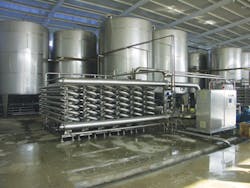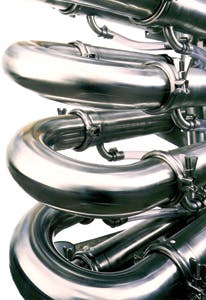Membrane System Helps Clean Up Sugary Wash Water
By David J. Caldwell
National Raisin of Fowler, Calif., was faced with an interesting predicament. Sales and production of its products were rapidly increasing, yet at the same time so were its wastewater costs. To truly reap the benefits of the increase in sales and production, National Raisin needed to improve its method of cleaning the raisins. Fortunately, thanks to a new reverse osmosis membrane system, the company has been able to cut its wastewater costs and open up a potentially lucrative source of additional income.
Fowler is an agricultural community with lush grape vineyards and expansive farmland. With a population of less than 6,000, it's where the majority of raisins, the most popular sun dried fruit in the U.S., are produced.
Brothers Ernest, Krikor, and Kenneth Bedrosian founded National Raisin in 1969 with a mission to achieve the highest possible quality standards of any processor within California's raisin industry. National Raisin has grown to be one of the largest independent raisin processors in the industry. Its 60-acre, state-of-the-art facility in the heart of the fertile San Joaquin Valley processes over 100 million pounds of raisins annually.
Before shipment, the raisins undergo a 35 cycle cleaning process and a thorough, documented inspection by the company's quality assurance team. As an added quality guarantee, National Raisin has contracted with the United States Department of Agriculture (USDA) for full-time quality inspection services to work jointly to further verify the company's standard as the "World's Cleanest Raisin."
Cleaning Means Wastewater
National Raisin realized its wastewater costs from cleaning the raisins were rising rapidly, and in an area of the country where water is not taken for granted, it decided it needed to find ways to improve this important part of its business.
In processing about 200 tons of raisins daily with its "Laser Kleen" systems, the company generates between 60,000 and 80,000 gallons a day of wastewater, primarily from the raisin-washing process.
Since the product is sun-dried outdoors, the raisins have a fine coating of dust blown onto them from the sandy soil found in the Central Valley. This needs to be washed off before packaging.
Regulations concerning water run-off and the need to protect much needed local aquifers are strict and the Bedrosian family, long-time residents of the area and solid corporate citizens, wanted to do everything possible to provide for a sustainable business. This meant that standard solutions for disposing of the wastewater wouldn't suffice.
If dust was the only problem, simple settling tanks or filters could eliminate it and the raisins' wash water could be re-used for irrigation and other purposes, or disposed of at the local wastewater plant at very minimal cost.
However, the real problem with the wash water is that when it washes away the dust on the raisins, some of the sugar in the raisins also dissolves into the water.
When the wash water contains dissolved sugars, it creates a high biological oxygen demand (BOD) that increases the cost of disposal. This requires extensive paperwork for permits, ongoing regulatory review; and a variety of expensive steps to process this type of wastewater.
"This is a small town and we know just about everybody," said president Ernie Bedrosian, the eldest of the three brothers who own the company. "There are cheaper ways to dispose of the raisin wash water, but we wanted to do the right thing for the community."
For all of these reasons, the Bedrosian family wanted to find an alternative to land application of their wastewater and side products. Trucking the wastewater to the local municipal treatment plant wasn't an attractive answer. The municipal plant charges a premium to process water with high BOD and in National Raisin's situation it would cost about $50,000 per month, or more.
Membrane Treatment
National Raisin thought if it could remove the sugar from the wastewater it could return the water to the land. This plan would reduce municipal wastewater charges and eliminate the environmental concerns that came with land application of BOD effluent.
So, the decision to remove sugar from the wash water before disposal was easy. In fact, it would offer an added benefit. If the grape sugar concentration in the wash water was high enough, then it could be sold to local distilleries as an ingredient for grape alcohol. This type of alcohol is used to make fortified wines such as sherry and port as well as brandy. One local distillery said it would be interested in purchasing the wash water if it was a minimum of eight percent sugar. This meant that the sugar content had to be doubled or quadrupled from the two to four percent normally released in the raisin wash water.
The more difficult decision? Choosing the best process to concentrate the raisin wash water, since there were several options available.
The two most logical choices were using evaporation or reverse osmosis (RO).
Unfortunately, even state-of-the-art, high-efficiency evaporators operating under vacuum require a lot of energy to boil away enough wash water to concentrate the sugar to the desired level.
RO on the other hand only requires enough energy to generate pressure to force water through a filter membrane. This offers many benefits either in place of conventional evaporation technology or in conjunction with it.
• Low sugar content can be concentrated with reverses osmosis to a higher level that may be acceptable for other uses without the need for an evaporator.
• For higher sugar concentrations, reverse osmosis can provide an energy efficient pre-concentration to reduce the size and cost of the final evaporation system.
National Raisin's plant engineer, John Minazzoli, first considered spiral RO elements that are relatively inexpensive and require the least amount of floor space. However, dust and other grape solids (bits of stems and skins) were blocking the small channels in these spiral elements. Conventional pre-filters used upstream from the spiral elements also became blocked.
Ultimately, through contacts with the California Institute of Food and Agricultural Research (CIFAR) in Davis, Calif., and others, National Raisin was introduced to Peter Allan, now with an Ohio-based company, Membrane Specialists LLC, who are the exclusive distributor of PCI Membrane products in the Americas.
PCI Membranes, a manufacturer of membranes for separation and concentration since 1967, is a brand of Xylem Inc., a global company with $3.8 billion in sales, and offers process solutions for a wide variety of filtration applications using microfiltration, ultrafiltration, nanofiltration and reverse osmosis technologies.
The important advantage PCI tubular RO membranes provided were ½" tubular channels that don't require pre-filtration, and the polymer membrane surface is more resistant to abrasion than inert materials in prefilters such as ceramic membranes. In other words, with PCI's membranes National Raisin could accomplish its goal of sugar concentration in one step instead of two.
Pilot trials then proved that the tubular RO membranes would concentrate the sugar up to the required 8 to 10 percent levels for processing by a distillery.
After initial trials were completed, it was decided to install 80 B1 PCI Membrane modules from Xylem fitted with AFC99 Tubular Reverse Osmosis membranes in a continuous system, with expansion up to 120 modules in the future as National Raisin increases their capacity.
Re-Use and Increased Profit
Once the full system was running and the concentrated sugar water (called "retentate") had been removed, the remaining water (called the "permeate") was actually lower in dissolved solids than the well water that feeds National Raisin's plant. Therefore, this water was available for re-use or could be sent to irrigate nearby vineyards.
National Raisin is continuing their program of optimizing RO use for maximum return on their investment. The original cost of the installation was recouped in less than two years. Demand for grape sugar water tends to fluctuate (even dropping to zero occasionally), but the savings on National Raisin's wastewater disposal bill alone amount to around $300,000 per year. The disposal saving by itself is enough to keep the system return-on-investment within the original plan of three years. Any additional income that comes from selling the concentrated sugar water to distilleries is an added bonus.
About the Author: David J. Caldwell is a Product Manager for Xylem Inc. responsible for hygienic positive displacement processing pumps and tubular membrane technologies used in Bio-Pharmaceutical, Pharmaceutical, and Food & Beverage manufacturing. He can be contacted at [email protected]



